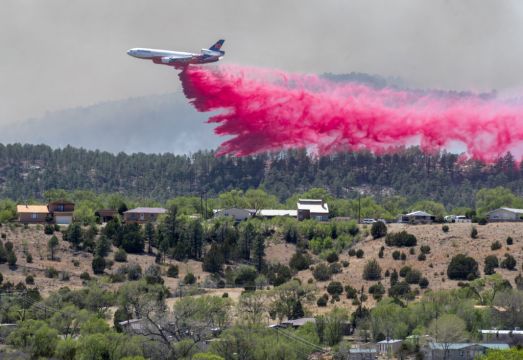Weather conditions described as potentially historic have been forecast for New Mexico over the next few days as hundreds of firefighters and a fleet of aeroplanes and helicopters work to extinguish the largest fire burning in America.
Forecasters are warning that winds could reach 50-60mph over the weekend, worsening the situation in the US state.
Many families have already been left homeless and thousands of residents have been evacuated due to flames that have charred large swathes of the Sangre de Cristo Mountains in north-eastern New Mexico.
Residents on the fringes of the shifting fire front hope that recent work to clear brush, install sprinklers, run hoses and use bulldozers to create fire breaks will keep the blaze from reaching the city of Las Vegas (not the larger, better-known city in Nevada) and other villages to the north and south.

“There’s uncertainty and there’s fear about how the winds are going to affect the fire from day to day,” said Elmo Baca, chairman of the Las Vegas Community Foundation. “Once the people are evacuated out of an area, they can’t go back, so they’re just stuck worrying.”
The blaze has devastated more than 262 square miles over the last few weeks.
The start of the conflagration has been traced in part to a preventive fire initiated by the US Forest Service in early April to reduce flammable vegetation. The blaze got out of control, merging with another wildfire of unknown origin.
We cannot overstate it enough!!! The next several days will be windy & exceptionally dry with above normal temperatures & unstable conditions. This long duration critical fire weather event will require all New Mexicans to be diligent & cautious! #NMwx #NMfire #OneLessSpark pic.twitter.com/rhVxpVPlMt
— NWS Albuquerque (@NWSAlbuquerque) May 6, 2022
Nationwide, close to 2,000 square miles have burned so far this year, with 2018 being the last time this much fire had been reported across the country, according to the National Interagency Fire Centre.
Predictions for the rest of the spring do not bode well for the West, where long-term drought and warmer temperatures brought on by climate change have combined to worsen the threat of wildfire.
Forested areas in southern New Mexico, Arizona and Colorado also saw an early start with blazes forcing evacuations and destroying homes last month.
Incident Commander Dave Bales said firefighters working in north-eastern New Mexico have been focused on protecting homes and other structures that hold generations of sacred memories.

The crews have seen extreme wind events before that usually last a day or two. But Mr Bales said this event could last five or more days with gusts topping 50-60mph.
He also warned that flames could be carried up to a mile away.
“This is an extreme wind event that is unprecedented,” Mr Bales said.
Another large wildfire burning in New Mexico was within five miles of Los Alamos National Laboratory, one of the nation’s key facilities for nuclear research and future production of plutonium components for nuclear weapons.
Wildfires can create widespread damage & even force some residents to evacuate their homes. Amidst all of the chaos that comes with disasters such as wildfires, here are a few high priority preparedness tips to remember: https://t.co/6snoU71cLf #NMfire
— NWS Albuquerque (@NWSAlbuquerque) May 7, 2022
Crews have burned vegetation ahead of the fire in an effort to reduce its intensity and the potential for spot fires.
At the lab, water tankers, a helicopter and heavy equipment are in position and firefighters will patrol the perimeter if flames get any closer.
Some nuclear watchdog groups and environmentalists have raised concerns about containers of nuclear waste on lab property.
That includes six shipments of 109 containers awaiting transport to the federal government’s underground waste repository, state officials said.
Lab officials said radiological and other potentially hazardous materials are stored in containers engineered and tested to withstand extreme environments, including heat from fire.







